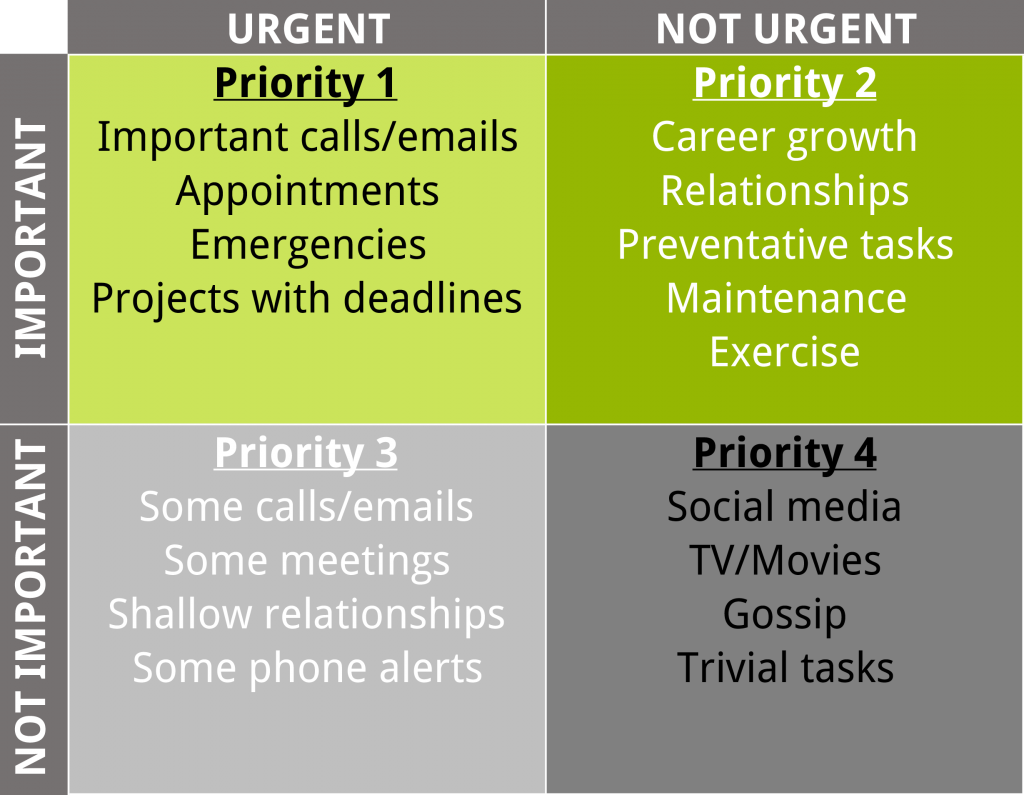If you’ve ever read the 7 Habits of Highly Effective People by Stephen Covey for school or work, then you should remember one important concept: how to prioritize tasks using the Eisenhower Method of Time Management. The concept is simple. When you plan your time, you should prioritize tasks that are important both in the short term (urgent) and in the long term (not urgent) over tasks that are not important to you. Tasks can be classified using any of 4 combinations of urgent and important.

There are four quadrants in the Eisenhower Matrix:
- Urgent and Important – Items in this quadrant have an immediate deadline, such as important meetings, appointments, calls, or emails. Emergencies are also prioritized in this quadrant. Keep in mind that if you experience a major life event, such as changing jobs, relocating, getting married, or having a child, you will likely have a lot of tasks in this quadrant. However, as you get settled, plan, and become more efficient, you will have fewer emergencies and urgent tasks. For example, your car is less likely to break down if you keep up with your scheduled maintenance.
ACTION: Complete these tasks immediately and urgently - Not Urgent, but Important – This quadrant includes goals for education, maintenance, time planning, relationships, exercise, finances, and career planning. Quadrant 2 represents “adulting”. These items are important for your long-term growth and development but do not seem so important in the now. In order to complete tasks in this quadrant, you will often need to slice them into smaller chunks and include deadlines that allow you to plan for long-term deadlines.
ACTION: Slice these tasks into smaller chunks, give them deadlines, and then complete them yourself - Urgent, but Not Important – Items in this quadrant sometimes seem important because of their urgency, such as a full email inbox, some meetings, some calls, and other interruptions. You should quickly reduce these items. Screen your calls, filter your email, sort your mail directly into a recycle bin, and decline meetings that don’t provide any value to your life and career.
ACTION: Automate, reduce, and reject these tasks as much as possible - Not Urgent and Not Important – The last quadrant is filled with time-wasters, such as checking social media, shopping online, watching cat videos, or watching television. You should minimize Q4 items, but don’t remove them completely. Sometimes you need some downtime.
ACTION: Remove all but a few of these tasks from your life
When you sort tasks into the quadrants, carefully consider what it means for something to be urgent or important:
- Urgent – Urgent tasks require immediate attention. Urgent items need to be done NOW, which causes stress and a reactive mentality. If you have a lot of tasks in this category, it can take over your life, leaving you in a constant state of panic and a feeling that you’re buried under life. You need to work hard and work smart to live in the important but not urgent quadrant.
- Important – Completing tasks can be important for many reasons:
- Important for your career growth
- Financially important, such as paying bills on time, paying down debt, or saving for the future
- Important for your physical/mental health
- Important for your interpersonal relationships, such as spending time with friends and family
- Important for your soul, whether you are religious or not, add tasks that make you a better person
To learn more about implementing the Eisenhower Matrix into your organizational system, see To-Do Lists.




